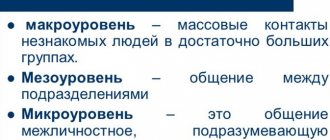Modern society cannot function normally without people interacting with each other. Each personality is individual, but, undoubtedly, it is believed that it must adapt to different situations. This allows a person to find a job, a partner, or go on a trip. A person’s manner of communication and behavior is formed throughout his life. They may change, be supplemented with other techniques, and any one type may be lost. Factors and reasons are very different. There is only one goal: to achieve results. Through communication, a person can achieve a lot; you just need to choose the right style of communication and behavior.
Communication styles
Communication style is characterized by a habitual, stable connection between the methods and methods of communication and the goals it pursues. That is, these are some features of interaction between people. A person is looking for a new job, comes for an interview - here he uses one style of communication, when interacting with colleagues - another, in the family and in communicating with relatives - a third. Different communication styles are chosen for each specific situation. No matter what action is taken, a person's words will always be the basis of communication.
Communication styles from a psychological point of view
Psychology has always dealt with problems of interaction between people. According to psychologists, communication style is determined by a person’s ability to choose certain means of behavior in a certain situation. They divided communication styles into three categories:
- flexible;
- rigid;
- transition.
With a flexible style, a person is well oriented in society, he can adequately assess who is in front of him, quickly understand what is being said, and even guess about the emotional state of the interlocutor. With a rigid style, a person cannot quickly analyze not only his own behavior, but also the behavior of his interlocutor. He has poor self-control and cannot always choose the appropriate way of behavior and communication. With a transitional style, a person has signs from the two above-mentioned styles. He does not fully understand what is happening around him, with whom he communicates and what method of interaction is best to choose.
Signs
What characteristic features correspond to an authoritarian communication style? This:
- All decisions are made by one person, without the ability of other group members to challenge them.
- The opportunity for group members to contribute to the organizational work is minimized or completely absent.
- Suppression of the will and desires of surrounding people, sometimes even contrary to common sense.
- Extremely aggressive behavior in the event of conflict situations.
These signs are characteristic of an authoritarian person, regardless of what group of people he is in, among his family and friends, among his subordinates or his students.
Exploring Communication Styles
When studying communication techniques, you need to know that the style of communication in itself and the style of communication in any situation are different concepts. If you do not take into account the characteristics of a person’s character and the characteristics of the situation in which he finds himself, then the explanation will simply be meaningless. There are a large number of methods for studying communication styles. For example, A.V. Petrovsky created a system of pedagogical interaction consisting of two components. It was called the style of pedagogical communication.
In 1938, attention was paid to communication styles for the first time. German psychologist Kurt Lewin conducted a study and developed a classification of relationships between people who manage and people who are forced to obey. Subsequently, it became generally accepted and is still in effect. His teaching communication styles include:
- authoritarian;
- democratic;
- liberal.
The teacher and the student are a system of relationships. Models of communication between teachers and students.
The two main figures in an orphanage are the teacher and the pupil. Their communication in extracurricular activities and at leisure becomes an important condition for the effectiveness of the educational process and environment.
Being a real teacher is a talent. After all, a teacher must be able to convey his experience and knowledge to children. Probably, every teacher wants his student to achieve success in the future. And, of course, it’s nice when that’s exactly what happens.
Why do children love and accept one teacher, but simply not accept another? I think that this problem is close to every child and every teacher. In general, you can answer this question in different ways. But everything is explained by the difference in characters. There are no absolutely identical people. Therefore, what some people like, others are not always ready to accept.
However, relationships with teachers occupy a very important place in children's lives, and children are very worried if they do not work out. The basis of the teacher’s relationship with the pupils is compliance with moral standards, trust and attention to the child’s inner world, showing kindness and cordiality towards him.
The teacher’s psychological perception and understanding of children contributes to effective cooperation between them, creates the opportunity for the teacher to enter the child’s mental world, objectively assess his state of mind, his speech, habits and behavior patterns, and capture the mood and experiences of the students. Therefore, one of the important conditions for fostering a culture of communication is the cooperation of the teacher with the children. In the technology of cooperation, the teacher, when communicating with children, adheres to the principle: “Not next to and not above, but together!”
The most important aspects of cooperation:
- the ability to listen to each other;
- make joint decisions;
- to trust each other;
- feel responsible for the work of the group.
It all starts with the teacher, with his ability to organize pedagogically appropriate relationships with children as the basis of creative communication. A teacher is someone who shares knowledge, wisdom and experience, and the child adopts them. Thus, it is necessary to find an answer to the question: how to build a relationship with a student so that interaction with him allows for maximum results in the field of education, upbringing and personal development, and at the same time remains promising for further constructive communication. The answer to this question may be the “teacher-pupil” interaction model, the purpose of which is to optimize the educational process.
Currently, our society is on the path to establishing a new alternative model of the relationship between teacher and child. It was called the “Subject-Subject” model. Its essence lies in changing the position of the teacher. If he takes into account the characteristics of the child being educated, his needs, emotions, capabilities, and also stimulates the child’s activity, without suppressing with his authority, then in this case the object of pedagogical activity becomes its subject. This is how pedagogical activity turns from traditional subject-object activity into subject-subject activity, which makes it complex, non-standard, and creative. In the course of pedagogical activity, a special communication arises between the teacher and the child, in which the participants find their own view of the world. The task of pedagogical activity in the context of a dialogue between the cultures of the teacher and the child is twofold: on the one hand, to strengthen and develop the child’s ways of thinking, position, and picture of the world; on the other hand, organize interaction with another culture. S.L. Rubinstein repeatedly emphasized that the pedagogical process shapes the child’s personality to the extent that the teacher guides his activity and does not replace it. During subject-subject interaction, the teacher understands his students more personally; such interaction is called personality-oriented. A personality-oriented teacher maximizes the development of the child’s ability to realize his “I” in connections with other people and the world in its diversity, to comprehend his actions, to foresee their consequences, both for others and for himself. Pedagogical activity in this kind of interaction is dialogical in nature. M. Bakhtin believes that a child only in dialogue, entering into interaction with another subject, knows himself, through comparison with another, through
Also in pedagogy, there are several other models of communication between teacher and students:
- The dictatorial model of “Mont Blanc” is expressed in detachment from students, who for the teacher represent a faceless mass of listeners. Pedagogical functions are reduced to an information message. The consequence of this model is the occurrence of psychological discomfort or a complete lack of contact.
- The “Chinese Wall” model is expressed in a weak connection between the teacher and students due to the lack of desire to cooperate. Contact is established in order for teachers to emphasize their status, so students have no interest in the subject and there is an indifferent attitude towards the teacher’s personality.
- The “Locator” model of differentiated attention is expressed in a selective attitude towards students. The teacher focuses on certain children: talented, weak, outsiders. This model arises due to an inept combination of an individual approach with a frontal method of teaching. As a result, situational contact and disruption of interaction in the “teacher – team of students” system are dominant.
- The monoreflexive model of “Teterev” is expressed in the fact that the teacher is closed in on himself, his speech is monotonous, and there is no reaction to the listeners. He hears only himself and does not allow students to engage in discussion. The consequence of this model is the formation of a logical vacuum. The educational impact is formal in nature, since the participants in communication are isolated from each other.
- The model is hyper-reflective. It is important for the teacher how his information is perceived by students. Interpersonal relationships are elevated to an absolute level, so the teacher constantly doubts the correctness of his behavior; permanent tension leads to a nervous breakdown, which is expressed in inadequate reactions to the actions of students.
- Model of flexible response "Robot". Communication is built according to a strict algorithm, there is an impeccable logic in presenting the material, but at the same time the teacher does not take into account the situation and the psychological state of his students.
- Authoritarian model “I myself”. The learning process is teacher-centered. The basis of communicative behavior is suppression, and the consequence is the lack of initiative of students.
- The “Union” model of active interaction is a model of friendly interaction and a positive mood, allowing his choice and his choice.
The nature of the interaction between teacher and student determines the style of pedagogical activity. A.K. Markova differentiates democratic, authoritarian and liberal styles of pedagogical activity and describes them as follows.
With a democratic style of pedagogical activity, the child is considered as an equal partner in communication and cognitive activity. The teacher involves children in decision-making, takes into account their opinions, encourages independent judgment, and takes into account not only academic performance, but also personal qualities. Methods of influence are encouragement to action, advice, request. Teachers with a democratic style of interaction are characterized by greater professional stability and satisfaction with their profession.
With an authoritarian style, the child is viewed as an object of pedagogical influence, and not an equal partner. The teacher makes decisions alone, establishes strict control over the fulfillment of the requirements placed on him, uses his rights without taking into account the situation and opinion of the child, and does not justify his actions to him.
As a result, children lose activity or carry it out only when the teacher plays a leading role, and exhibit low self-esteem and aggressiveness. The main methods of influence of this style are orders and teachings. Teachers are characterized by low satisfaction with their profession and professional instability.
With a liberal style, the teacher moves away from making decisions, transferring the initiative to children and colleagues. Organizes and controls the activities of children without a system, shows indecision and hesitation.
There is also a classification by V.A. Kan-Kalik, in which he identifies the following styles of pedagogical communication:
- communication based on passion for joint creative activities;
- communication based on friendship;
- communication distance;
- communication intimidation;
- communication-flirting.
The most fruitful, according to V.A. Kan-Kalik, is communication based on passion for joint creative activity. This style is based on the unity of the teacher’s high professionalism and his ethical principles. Passion for creative research together with students is the result not only of the teacher’s communicative activities, but to a greater extent of his attitude to teaching activities in general.
The style of pedagogical communication based on a friendly disposition is also productive. This style of communication can be considered as a prerequisite for successful joint educational activities. Friendly disposition is the most important regulator of business pedagogical communication. This is a stimulator for the development and fruitfulness of relationships between teachers and students. But it should be noted that friendliness, like any emotional structure and pedagogical attitude, must have a measure. In this regard, V.A. Kan-Kalik draws attention to the following situation: young teachers often turn friendship into familiar relations with students, which negatively affects the entire course of the educational process. Friendliness must be pedagogically appropriate.
Distance communication is common . This style of communication is used by both experienced teachers and beginners. Its essence lies in the fact that in the system of relationships between a teacher and a student, distance acts as a limiter. But the transformation of the “distance indicator” into the dominant feature of pedagogical communication sharply reduces the creative level of collaboration between teacher and student. This often leads to the establishment of an authoritarian principle in the system of relationships between the teacher and children, which ultimately negatively affects the results of activities.
Communication-distance is a transitional stage to such a negative form of communication as communication-intimidation. Researchers associate this style of communication mainly with the inability to organize productive communication based on passion for joint activities. Beginning teachers sometimes turn to him. It is quite difficult to form productive communication, and young teachers often follow the line of least resistance, choosing intimidating communication or distance in its extreme manifestation. Communication and flirting also plays an equally negative role in working with children. This type of communication corresponds to the desire to gain false, cheap authority among children, which contradicts the requirements of pedagogical ethics. The emergence of this style of communication is caused, on the one hand, by the teacher’s desire to quickly establish contact with children, the desire to please, and on the other hand, by the lack of the necessary general pedagogical and communicative culture, skills and abilities of pedagogical communication. Each of these styles, identifying the attitude towards the interaction partner, determines its character: from subordination, following - to partnership and to the absence of directional influence.
It is important that each of these styles presupposes the dominance of either monologue or dialogic forms of communication.
A teacher with a stable, emotionally positive attitude towards children, a business-like reaction to shortcomings in academic work and behavior, and a calm and even tone of address, has children who are relaxed, sociable, and trusting. The correct style of communication creates an atmosphere of emotional well-being, which largely determines the effectiveness of educational work. The correctly found style of pedagogical communication, corresponding to the unique individuality of the teacher, contributes to the solution of many problems.
The teacher approaches children with a special feeling, that is, sympathizes with them. The process of perceiving and understanding a child is associated with the ability and culture of listening carefully. Observations show that most teachers in the communication process do not comply with the culture of listening to the student. Meanwhile, the culture of listening is of great importance in the process of mutual communication and establishing relationships. The ability to listen ensures the effectiveness of “entering” into communication and understanding each other. A teacher must have the ability to listen, since listening to a student is an integral part of teaching activity.
If a person expresses impatience, does not listen to the end of the interlocutor and interrupts him, he is showing disrespect for the interlocutor and, to some extent, a lack of culture. In such a situation, it is necessary to reassure the listener, set him up for a positive perception, and interest him in the prospect of solving the problem. And then the interlocutor’s aggressiveness will take on the character of minor misunderstandings. In these conditions, it is advisable to use phrases and questions approximately in the following order: “Please tell me, did I understand you correctly?”, “Do you agree with this?”, “Is this your firm belief?” There are also situations when one of the interlocutors, without listening to the opinions of others, continues to develop evidence for his point of view, thereby expressing disdain for other positions. This behavior causes a negative attitude towards this participant in communication. The technique of active listening can be used in any process of communication between a teacher and children. For example, children are very upset, sad, they are haunted by failures, they have encountered some obstacles, their mood has dropped. In these and other difficult situations, the teacher can use the technique of active listening. He must know how to express sympathy for children in such cases in order to awaken positive emotions in them and be able to remove children from a state of stress and depression. But if the students are overly excited or overly excited, then it is not possible to establish communication through active listening, since at such moments they do not completely control their feelings and experiences and do not perceive the content of the words addressed to them. The teacher needs to calm the children down, bring them into a state of self-control, and only then establish communication. In a situation where an atmosphere for communication has been created, the teacher can use the method of calm listening. In order for children to communicate and listen to the teacher in a calm environment, the teacher must have stability, endurance and patience.
Pedagogical tact and sensitive attitude towards students certainly play a decisive role in the success of the teacher’s work. This is a very important aspect of a teacher’s skill. And the relationship between teacher and student largely depends on it. But pedagogical tact does not completely solve the problem of relationships.
Foreign researchers in their studies also indicated that children tend to prefer teachers who have the following characteristics:
- Human qualities - kindness, cheerfulness, responsibility, balance.
- Organizational qualities - fairness, consistency, honesty, respect for others.
- Business qualities - usefulness, democracy, ability to interest.
- Appearance – well dressed, pleasant voice, general attractiveness.
Older students named popular educators those who know how to present educational material clearly, vividly, and problematically. I would like to note that in the “teacher-pupil” relationship, in addition to highlighting certain personal or professional qualities of the teacher, it is also assumed that the child’s expectations are taken into account, which are partially expressed in specific requirements for the teacher’s behavior. It is important to study them in terms of age, i.e. find out what children of different ages want and expect from a teacher, and how these expectations change from one age threshold to another.
The teacher’s inability to meet the child’s expectations and inattention to these expectations can give rise to a negative attitude towards the teacher himself, towards his work, and lead to acute conflicts.
Conflicts are phenomena of extremely diverse nature. They can be internally personal, a collision of two incompatible desires, opposing tendencies, when the main needs of the individual are not satisfied, damage is caused to the values of the “I”. Usually, conflicts occur between a teacher and a pupil in adolescence. It is important here that the teacher must clearly understand the main causes of conflict relationships and know real ways to prevent them.
Specific causes of “teacher-pupil” conflicts Insufficient professionalism of the teacher, manifested in the nervous relationship between the teacher and children:
- in demonstrating their superiority, their special status;
- in serious errors of interaction, such as discrimination against individual students, open or disguised violation of pedagogical ethics due to the struggle for leadership;
- in the pedagogically unprofessional actions of educators: an orderly tone, a shout from the teacher, which often provokes gross violations of children’s discipline;
- in the teacher’s biased attitude towards children, manifested in the systematic underestimation of grades and the selection of “favorites”;
- inability to organize cognitive interest in children;
- in “labeling”, for example, an underachieving student;
- in focusing the attention of others on the psychological problems and shortcomings of the student;
- in assessing an action based on the subjective perception of the child’s personality;
- inability to organize classes with all students.
How do students want to see their teacher?
- Moral quality (fair, respects human dignity, trusting).
- Love for your students
- A high-quality, good teacher who wants to make children’s lives exciting and interesting, does not like to command, and gives good advice.
Negative qualities of educators:
- Screams, interrupts, does not listen to the end.
- Identifies individual students.
- Picky, tries to punish for every offense.
- Requires unconditional obedience from the student.
- Treated like little ones.
- Disrespectful.
- Can't keep a secret.
How can you prevent conflicts and how to ensure that teachers and students have good relationships:
- Skillfully spend educational hours, not leave a single child inactive.
- Create an atmosphere of continuous communication with the group.
- Excellent knowledge of the material that I would like to convey to the pupils, fluency in it. Application of different methods and forms in work.
- Fulfillment and desire to achieve the goal: to achieve complete mastery of the material with all students without exception.
- Rational use of time, values every working minute.
- Organize work with “difficult” children, constantly ask, force them to think, find more interesting ways to spend their free time.
- Respectful attitude towards the individual by pupils, not allowing all kinds of insults, nicknames, comments.
And no matter what innovations are introduced, in pedagogy, as hundreds and thousands of years ago, there are participants in the educational process: the teacher and the student. Between him (always) there is an ocean of knowledge and reefs of contradictions. And that's okay. Any ocean contradicts, hinders, but those who overcome it endow with constantly changing landscapes, the vastness of the horizon, the secretive life of its depths, the long-awaited and unexpectedly growing shore. And the teacher will always be the captain on this voyage, the chief navigator of the navigation through the reefs
Characteristics of pedagogical communication styles
Pedagogical communication styles were defined as emotional techniques and actions of the teacher in relation to the student. The teacher's behavior is determined by his understanding of the goal that he pursues in teaching the child. Most often, this is nothing more than teaching a child the basics of his subject, transferring skills that the student will need to complete a task, or that will be useful to him in later life. At the same time, the teacher also takes into account the child’s communication styles. Communication with children is completely different from that with adults. The teacher needs a little more time, effort and attention to explain the material to the child. Communication itself occurs through instructions, explanations, questions, comments and even prohibitions.
Types and examples
An authoritarian communication style is often observed in parent-child relationships. At the same time, the parent is not interested in the child’s preferences and hobbies; his vision of the situation is in the foreground.
For example, a father orders a child: “You will play football,” and sends him to a football club, despite the fact that the child is not interested in playing this sport and would prefer to learn to play the piano.
However, the influence of the father remains decisive, who in case of disobedience can punish the child.
Authoritarianism among managers is manifested in the issuance of strict instructions and constant control over their implementation.
The employee is given a clear instruction that he must follow without showing initiative .
For example, a manager orders an employee: “The quarterly report should be on my desk by 2 p.m. today. If you fail to comply, you will lose your monthly bonus.”
The leading incentive with such an order is the deprivation of material benefits to the employee , and the possibility of incentives is not even considered.
The authoritarianism of the teacher when communicating with students can be expressed in a constant focus on the negative assessment of the results of their activities.
For example, a teacher says to an excellent student: “Petrov, you get a 3 on the test, so your quarter grade is reduced to 4,” while the teacher knows very well that the failure of a generally capable student is justified by the fact that he was ill for a long time and missed important thematic lessons.
However, the authoritarianism of the teacher does not allow him to single out the student as an individual, approach him individually and promote extracurricular activities on a missed topic; the teacher is guided by the general principles of assessing the activities of students, without going into specific details.
In married couples, authoritarianism in the communication style of one of the spouses is expressed in the fact that only he makes decisions that generally affect the life of the entire family , without taking into account either the opinions of the rest of its members or the consequences of his own decisions, which may be in some way negative towards other members.
A simple example of this style of communication in a family is when a husband says to his wife: “We are starting to save for a car, so your studies are put off until later.”
This decision sounds like it has already been made and does not tolerate any objections. Moreover, it must be carried out unquestioningly, despite the fact that it may exclude the goals of one of the partners.
Authoritarian communication style
An authoritarian style of communication implies that the teacher reserves the right to resolve issues independently. They can concern relationships between students, activities in the classroom, or concern each student personally. As a rule, such a regime includes both dictatorship and concern for subordinates. With such teachers, students can rarely open up fully and show their capabilities. Initiative can cause conflict between teacher and student. The teacher’s belief that only his thinking is correct and everything else is false does not allow both parties to interact productively. The child's answer cannot be adequately assessed because the teacher simply does not understand the student and is based only on performance indicators. His bad actions always come to the fore in the eyes of the teacher, while the motives for his behavior are not taken into account.
Authoritarianism, concept
Authoritarianism is an inherently political concept, derived from the Latin word “auctoritas” (influence, power), which implies the concentration of power in the state in the hands of one person or a small group of people.
In psychology , authoritarianism is a characteristic of a person who constantly strives to subjugate the people around him as much as possible, influence them, and also achieve certain goals at the expense of others.
The authoritarian style of communication shows itself most clearly in professional, business relationships, as well as in education or training.
However, it can also exist in interpersonal communication , when informal leaders are formed in a group of people, individuals who do not have official leadership rights, but enjoy such strong authority that the rest of the participants in such a social group unquestioningly follow their instructions and demands, and also take them for granted. the comments they make allow them to judge themselves and point out shortcomings.
Democratic style of communication
The democratic style of communication is considered the best, because the teacher strives to help the student, use all his strengths and capabilities, and activate the child’s role in the life of the class. Interaction and collaboration are the main goals of this style. The teacher evaluates, first of all, the good actions of the student, treats him well, understands him and supports him. If the teacher sees that the child does not have time to assimilate information or does not understand something, then he will definitely slow down the pace and explain the material more carefully, putting everything in order. The teacher adequately assesses the student’s capabilities and can predict the direction of his development. He takes into account the interests and wishes of his students. Some methods of teaching and communicating with students of teachers of the democratic style are slightly inferior to the methods of the authoritarian style of their colleagues, but the “climate” in the classroom is still better for the former. Children feel much freer.
Liberal communication style
The teaching styles of a liberal style teacher differ from those included in other teacher communication styles. He strives to reduce all chances of taking any part in the life of the class, and does not want to bear responsibility for the students. The teacher is limited to performing exclusively his pedagogical functions. The teacher's communication styles that he combines in his work lead to poor academic performance. He is somewhat indifferent to the problems of both the school and the children, as a result of which it is very difficult for him to control the students.
Characteristics of business communication styles
Business communication styles imply any actions or methods of communication aimed at achieving any result. In this case, the main task of those participating in the conversation becomes to reinforce the idea of themselves as a member of the team or society as a whole. The participant, as it were, puts on his festive mask and becomes a different person for a while. This peculiar ritual, on the one hand, sometimes seems meaningless and boring, but on the other hand, it is a game, the rules of which a person knows in advance and must follow.
Stereotypes
There is a lot of talk about the authoritarian personality type. Therefore, one should not be surprised at so many speculations about her. The main one says that people prone to authoritarianism are always narrow-minded, lack moral values, show violence, and manipulate others. For many, they are despots and even fascists. This view was adhered to and promoted by E. Fromm and K. Levin.
How are things really going? An authoritarian personality really strives for power, often showing despotism. But she can do this in other ways. One of them is to create a respectful atmosphere around himself, which will help him build authority.
It is difficult to say unequivocally whether it is good or bad to be an authoritarian person. But it is worth noting that many managers of large companies and enterprises are like this. And this can be considered a reason for pride, since this quality helps them work more efficiently than others.
People who tend to be authoritarian often place high demands on themselves and others. This is another plus. They not only exercise discipline themselves, but also teach it to their subordinates. The exception is when an authoritarian person demands a lot from others, but at the same time remains disorganized.
Ritual style of communication
Business communication styles like ritual are often used in companies whose members have known each other for a long time. And so they meet, spend some time together, and it seems that after these years the topics discussed in these companies do not change at all. Sometimes you can even predict what one or another participant in the conversation will say, but, nevertheless, everyone is happy with everything and after the day, some even feel satisfied with the time spent. This style of communication is considered a typical case of a ritual style, where the quality of communication comes to the fore, and not its content. Thus, the same reinforcement of the idea of oneself as a member of a team occurs, where everyone occupies some place, everyone is important. His opinions, values, and worldview are important.
Cases when a person who, when asked: “How are you?” always answers unequivocally: “Fine,” and now suddenly begins to tell a detailed story about his life, family, children and work, which is called going beyond the ritual. Such atypical behavior of a person, whose reaction could always be guessed, violates the idea of ritual, because the main thing is to wear a mask, be it in social relationships or interpersonal ones.
Democratic style, or “Let's think together”
Alexey K., a young manager, left Gennady Pavlovich’s company and founded his own business. He decided to learn from the mistakes of others and realized that he would not allow such a dictatorship as reigned at his previous place of work. Alexey recruited young employees who were more like-minded than his subordinates. From the first days, he began to adhere to a democratic leadership style: he discussed the company’s development strategy with employees, listened to their ideas and opinions, and trusted them to work on projects independently. For the workers, he was not a strict boss, but his friend Lekha. One day this almost ruined the company: the employees relaxed and stopped taking Alexey seriously. Some people began to be late, miss the deadlines for completing tasks, and to the bewilderment of the boss they said: “Whatever, I’ll do it, don’t worry!” When deals with profitable clients began to fall through and the company lost profits, the young businessman realized that it was time to change something.
Democratic management style is a deceptive thing. To the young and modern, it seems to be the only acceptable one and in keeping with the spirit of the times (well, don’t work the old fashioned way!), but if you loosen the reins a little, it will turn out like in the example above. To prevent democracy from turning into anarchy and permissiveness, the leader must have management experience.
In general, the democratic style is truly a priority in young modern companies. The manager does not make decisions alone - he consults with the team, organizes brainstorming sessions, and tries to ensure that each employee reveals his or her potential. He himself works as an equal or assigns himself the role of a consultant or mentor. If a democratic boss makes a mistake, he does not blame the staff for everything, but draws conclusions. At the same time, he remains the leader - he does not remove himself from the main role, does not emphasize that “we are all equal here, guys.” That is, a team is a team, but the hierarchy must be clearly built.
Disadvantages of the democratic style
- The possibility of anarchy, belittling the role of the leader, and the emergence of opposition in the team. In general, everything that was described using the example of Alexey K.
- Decisions can take a long time to make. The more people involved in the discussion, the longer the process may take. Time management and clear deadlines for setting tasks will save the day. For example, 3 days are given for discussion and introduction of improvement proposals - and not a second longer. This disciplines employees and speeds up business processes.
Pros of a democratic style
If mistakes are avoided, a democratic style can become the basis for creating a cohesive team.
- Strengthens team spirit, makes employees true like-minded people, united by one goal. It’s good if the company has a well-developed corporate culture - mission and values, main tasks for the coming years, a common Big Idea.
- Reduces the number of errors in work. The more people involved in solving a problem, the greater the chance that the optimal option will be found. Just remember that the discussion should not drag on.
- Minimal staff turnover. Why leave the team if you share its values and objectives, and feel involved in one common goal? That's right, there's no need. Employees rarely leave companies with a democratic management style (if, of course, they join the team and share common values).
Manipulative communication style
With this style of communication, a person is perceived by others as a means to an end. As a rule, the interlocutor tries to show the best aspects of his goal so that he can help him achieve it. Despite the fact that both participants in the conversation have different ideas about the component of this goal, the one who is more skillful in the methods of manipulation will win. In such cases, the interlocutor knows about the reasons for the partner’s behavior, about his aspirations, desires, and can turn the development of events in the direction he needs. Manipulation is not necessarily a bad method. Many goals are achieved this way. Sometimes, in order to convince a person to do something, to force him to act, it is necessary to resort to a manipulative communication style.
This can be compared to the communication method of a middle manager. He speaks in one tone with his superiors, but with his subordinates in a completely different tone. Sometimes it is unpleasant, but there is no other way.
There are cases when a person’s entire communication style comes down to manipulation. Due to the too frequent use of this method on a person, his constant persuasion and pushing, the latter may consider manipulation the only correct way out of the situation.
Personality-oriented style, or “Don’t be afraid, I’m with you”
Olga B. worked with both Gennady Pavlovich and Alexey. The woman realized that both authoritarian and democratic styles have their pros and cons, and decided to act differently. Actually, she didn’t come up with anything new - she used a completely individual approach. Olga realized that you need to work with each employee in your own way, and what is suitable for one is categorically unacceptable for another. For example, a quiet person may be shy at general planning meetings and brainstorming sessions, but during a personal conversation he will begin to burst out with creative ideas. It is difficult for an owl man to arrive at the office at 9 am - his head is not clear, things are not getting done, but in the evening the most fruitful time comes. Olga organized a free schedule for several of her comrades and allowed introverts not to speak at the planning meeting in front of everyone. The employees appreciated the good attitude and began calling the boss “our mommy.” But there’s nowhere without a fly in the ointment: a group of people quickly emerged who considered a good attitude a weakness and began to openly neglect work. Olga was worried, had soul-saving conversations, and only when the team submitted a collective request for the dismissal of those at fault, she decided to take a bold step.
Practicing an individual approach is the right thing to do. Typically, bosses of this type (usually women) like to conduct psychological testing, organize corporate parties and get-togethers in order to get to know their employees better. However, you shouldn’t overprotect your employees: you are not a mother hen, and they are not helpless chickens. Trust, but verify, be not a mommy, but a boss - this is the moral of this fable.
Disadvantages of a person-centered approach
- As a rule, bosses of this type are soft, sensitive people. Good relationships are more important to them than the company’s profit and its development. Therefore, sad as it may be, a soft-spoken boss can quickly be “eaten up” by his more resourceful colleagues or one of his subordinates.
- No delegation of authority. Instead of clearly issuing instructions and monitoring the process of completing tasks, such managers either do everything themselves or forgive endless delays. Wake up guys, this is a business! Here you need to make tough decisions and take big risks, otherwise you risk going broke and going bankrupt.
Advantages of an individual approach
- Good relationships in the team. Human relations are perhaps the most important thing for half of the employees. If you are lucky enough to find an understanding boss, many will hold on to this position with their hands and teeth, even despite the low salary and small career prospects.
- In a crisis situation, employees will stand behind the boss and will not allow the company to collapse . “One for all, and all for one” - this slogan still works.
Humanistic style of communication
With the humanistic style of communication, we are talking about interpersonal relationships in which a person wants to be understood, supported, given advice, to be empathized with. Initially, this type of communication does not imply any goal; the situation consists of ongoing events. This style of communication can be called the most sincere of all existing ones, where those very events are intimate, confessional in nature. The main method that works here is suggestion, and mutual. Each partner inspires the other that he is worthy of trust, that one is ready to listen, and the other is ready to tell what worries him.
Such communication can occur not only between loved ones and relatives. For example, in a few tens of minutes a person can recognize the interlocutor who is traveling with him on the bus in the next seat or tell him a lot about himself, but he does not know the person with whom he has been working for several years. A conversation with a fellow traveler leads to some revelations about oneself, makes people feel each other, and empathize. But a conversation with a colleague has completely different goals.









